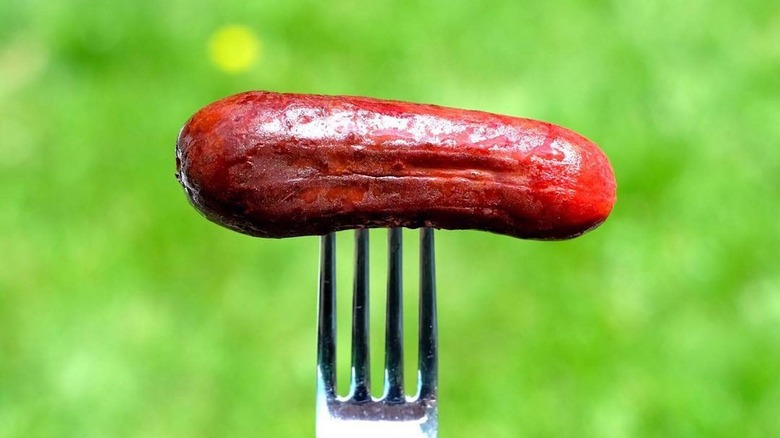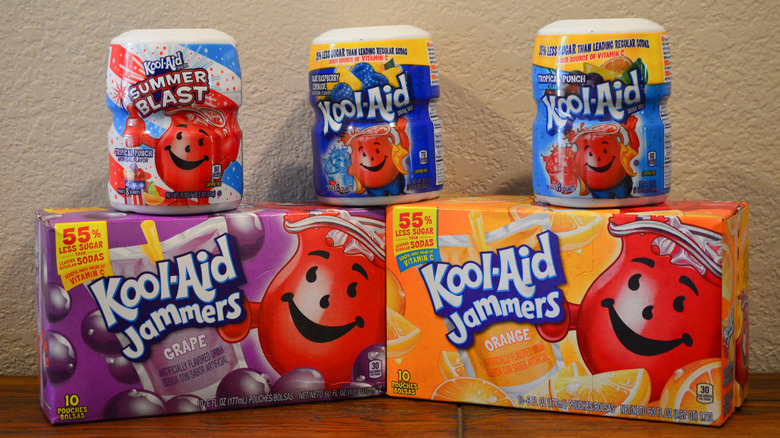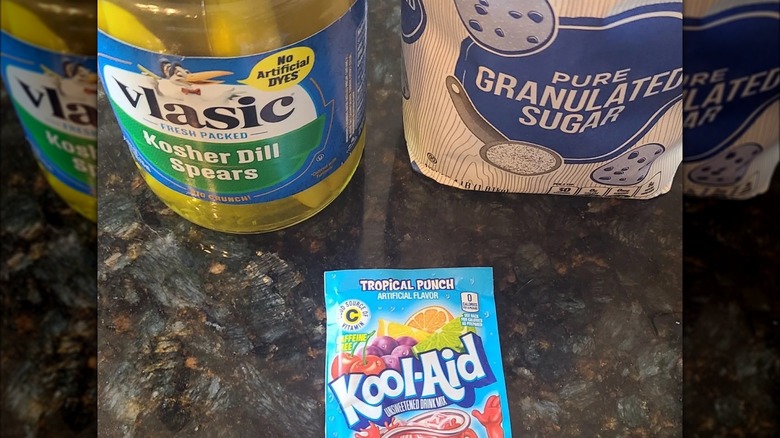Kool-Aid Pickles Are Rooted In Southern Tradition
While many beloved entries in the great American cookbook come out of the South, pickles infused with Kool-Aid are one of the more obscure, and they're definitely an acquired taste. Among the things you didn't know about Kool-Aid: It can be used to flavor pickles. Also known as Koolickles, Kool-Aid pickles have been a common homemade or store-bought snack for decades in the South, the region of their birth. Like so many other Southern classics, Kool-Aid pickles are easy to prepare with familiar ingredients, and are best when made at home.
So what do Kool-Aid pickles taste like? They taste exactly like how they sound — a mash-up between Kool-Aid and pickles. This is a taste that's very salty, sour, and dill-forward, balanced by the sticky-sweetness and artificial fruit flavor of the Kool-Aid mix. (The exact fake-fruit profile comes from whatever variety of Kool-Aid is used.) Here's everything you need to know about this Southern classic, no matter where you might be located.
Kool-Aid pickles trace back to the Mississippi Delta
Both Kool-Aid and pickles are time-tested summer treats. A glass of Kool-Aid is refreshing on a hot day, just as a pickle perfectly complements picnic sandwiches or a grilled hamburger with its cool crunch. During the summer months it gets particularly hot in the Southern U.S., and at some point in recent decades, an individual whose name is lost to history came up with the idea of combining Kool-Aid with pickles.
The Koolickle is widely believed to have originated in the Mississippi Delta area, a river-adjacent region that spans from Memphis, Tennessee, down to Vicksburg, Mississippi. Today Kool-Aid Pickles can be found throughout the greater South and beyond, with homemade versions sold as snacks to neighborhood kids. By the 2000s, Southern convenience stores were also selling Kool-Aid pickles to meet demand. The Double Quick chain later introduced a house brand of this colorful treat, and in 2017, Arkansas-based Walmart unveiled fruit punch-imbued pickles it dubbed "Tropickles."
Mixing sweet with sour is a distinctly Southern culinary practice, which is carried on by inventively combining pickles and Kool-Aid. For many years prior to this trend, pickles were speared onto peppermint sticks as a snack, and Southerners also used dry Kool-Aid drink mix as a dip for pickles.
How to make Kool-Aid pickles
Because they were originally prepared in kitchens for private consumption or local sale, a homemade Kool-Aid pickle is an authentic Kool-Aid pickle. Just a few common and cheap ingredients are required to turn a green and sour dill pickle into a scarlet sweet-and-sour dill pickle. Any flavor of Kool-Aid will do, although the varieties most often used in the South are ones that will send a pickle into somewhere in the spectrum of red, so consider using a heavily dyed flavor like cherry, tropical punch, or strawberry.
Preparing a batch the Southern way is just like mixing up a pitcher of Kool-Aid, but then dumping it on some pickles. Traditionally, the Kool-Aid brine is made from double-strength drink mix, meaning using a couple of packets of unsweetened Kool-Aid and doubling up on the added sugar while using less water than is usually recommended. This ensures an intensely flavored, sweetened, and colored marinade for the pickles.
Whole pickles aren't required; submerged slices, spears, or even chips will properly soak up the Kool-Aid. After that, it's a matter of waiting. The pickles need time to absorb the fruity sugar water, and that occurs during refrigeration for anytime from 24 hours to a week. Then, those Koolickles are ready. They are fast becoming one of the Southern foods the rest of the world needs to try, and just in time for summer.


